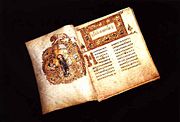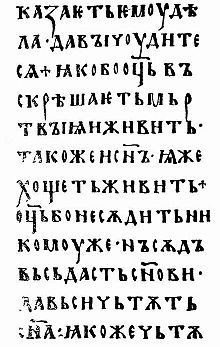
Ostromir Gospel
Encyclopedia

East Slavic languages
The East Slavic languages constitute one of three regional subgroups of Slavic languages, currently spoken in Eastern Europe. It is the group with the largest numbers of speakers, far out-numbering the Western and Southern Slavic groups. Current East Slavic languages are Belarusian, Russian,...
book (it was considered the first before the Novgorod Codex
Novgorod Codex
The Novgorod Codex is the oldest book of Rus’, unearthed on July 13, 2000 in Novgorod. It is a palimpsest consisting of three bound wooden tablets containing four pages filled with wax, on which its former owner wrote down dozens, probably hundreds of texts during two or three decades, each time...
was discovered in 2000). It was created by deacon
Deacon
Deacon is a ministry in the Christian Church that is generally associated with service of some kind, but which varies among theological and denominational traditions...
Gregory for his patron, Posadnik
Posadnik
Posadnik was the mayor in some East Slavic cities or towns. Most notably, the posadnik was the mayor of Novgorod and Pskov...
Ostromir
Ostromir
Ostromir was a statesman, voivod and posadnik of Novgorod in 1054-1057 and probably for some decades previous....
of Novgorod, in 1056 or 1057, probably as a gift for a monastery.
The book
The book is a illuminated manuscriptIlluminated manuscript
An illuminated manuscript is a manuscript in which the text is supplemented by the addition of decoration, such as decorated initials, borders and miniature illustrations...
Gospel Book
Gospel Book
The Gospel Book, Evangelion, or Book of the Gospels is a codex or bound volume containing one or more of the four Gospels of the Christian New Testament...
lectionary
Lectionary
A Lectionary is a book or listing that contains a collection of scripture readings appointed for Christian or Judaic worship on a given day or occasion.-History:...
containing only feast-day and Sunday readings. It is written in a large uncial
Uncial
Uncial is a majuscule script commonly used from the 3rd to 8th centuries AD by Latin and Greek scribes. Uncial letters are written in either Greek, Latin, or Gothic.-Development:...
hand in two columns on 294 parchment sheets of the size 20 x 24 cm. Each page contains eighteen lines. The book is concluded by the scribe's notice about the circumstances of its creation.
Three full page evangelist portrait
Evangelist portrait
Evangelist portraits are a specific type of miniature included in ancient and mediæval illuminated manuscript Gospel Books, and later in Bibles and other books, as well as other media. Each Gospel of the Four Evangelists, the books of Matthew, Mark, Luke, and John, may be prefaced by a portrait of...
s survive, by two different artists, and many pages have decorative elements. The close resemblance between this and the equivalent pages in the Mstislav Lectionary suggests they are both based on a common prototype, now lost. The two artists who produced the evangelist portraits were both heavily influenced by Byzantine models, but the style of the portraits of Saints Mark and Luke seems to derive from Byzantine enamelled plaques rather than manuscripts.

Later history
It is thought that the book was taken from one of Novgorod monasteries to the personal collection of the Russian tsars in the Moscow KremlinMoscow Kremlin
The Moscow Kremlin , sometimes referred to as simply The Kremlin, is a historic fortified complex at the heart of Moscow, overlooking the Moskva River , Saint Basil's Cathedral and Red Square and the Alexander Garden...
, where it was first registered in 1701. Peter the Great ordered it to be taken to St. Petersburg, where there was no mention of it until 1805, when it was discovered in the dressing room of the late Catherine the Great.
The Gospels were deposited in the Imperial Public Library in St Petersburg, where it remains. Alexander Vostokov
Alexander Vostokov
Alexander Khristoforovich Vostokov was one of the first Russian philologists.He was born in Arensburg, Governorate of Livonia, and studied at the Imperial Academy of Arts. As a natural son of Baron von Osten-Sacken, he received the name Osteneck, which he later chose to render into Russian as...
was the first to study it in depth, demonstrating that the Church Slavonic of the manuscript reflects the Old East Slavic linguistic background of the scribe. The first facsimile edition was published under Vostokov's supervision in 1843.
In 1932, the gem-studded book-cover induced a plumber to break into a case, remove and steal the binding, and hide the parchments behind a bookcase. Although the book was quickly recovered, no replacement binding has been provided to date.
See also
- Novgorod CodexNovgorod CodexThe Novgorod Codex is the oldest book of Rus’, unearthed on July 13, 2000 in Novgorod. It is a palimpsest consisting of three bound wooden tablets containing four pages filled with wax, on which its former owner wrote down dozens, probably hundreds of texts during two or three decades, each time...
(first quarter of 11th c.) | Svyatoslav's Miscellanies (1073, 1076) | Archangel GospelArchangel GospelThe Archangel Gospel is a Cyrillic Gospel Book manuscript written in 1092. It is the fourth oldest Eastern Slavic manuscript. The book is stored in the collection of Russian State Library. UNESCO added the Arkhangelsk Gospel to the international register Memory of the World Programme in 1997.The...
(1092) | Mariinsky Gospel (11th cent.) | Mstislav Gospel (1117) | Yuriev Gospel (1119) | Halych Gospel (1144) | Dobrila Gospel (1164) | Pantaleon Gospel (12th cent.) | Eusebius Gospel (1282) | Chelm Gospel (13th cent.)
External links
- Images from the Ostromir gospels
- Pages & description from the Russian National Library
- Ostromir Goepsl at the National Library of Russia (2007)

